
Entering the European market for cultural tourism products
Cultural travel products that are sustainable and that have a positive impact on local cultures and communities are popular among European travellers. Employing enthusiastic and knowledgeable local guides who are properly trained and can speak tourists' language well is essential for a successful cultural travel product. European tour operators and OTAs are the key sales channels. Selling directly to independent culture tourists is also important. Colombia, Ethiopia, India and Peru are among the top competing destinations.
Contents of this page
- What requirements and certifications must cultural tourism products comply with to be allowed on the European market?
- Through which channels can you get cultural tourism products on the European market?
- What competition do you face in the cultural tourism market?
- What are the prices for cultural tourism products in the European market?
1. What requirements and certifications must cultural tourism products comply with to be allowed on the European market?
The European tour operator market must comply with several regulations to ensure that its clients are safe and financially protected. To do business with the European market, you must align your business processes with theirs to meet their expectations. European tour operators expect you to meet conditions set in a Code of Conduct and/or Terms of Business. Sustainability in all areas of tourism provision is essential for all European tourism suppliers. You must include sustainable actions throughout all your business activities.
What are the mandatory and additional requirements that buyers have?
The mandatory and additional requirements for cultural tourism services are common across the broader tourism sector. They include:
- The European Package Travel Directive;
- General Data Protection Regulation (GDPR);
- Liability insurance and insolvency protection.
You can find out more in the CBI study 'What requirements must tourism services comply with to be allowed on the European market?'. This study will help you understand the legal, non-legal and common requirements that European tour operators must comply with. If you understand the requirements they are bound by and can adapt your business to meet their needs, they will be more likely to do business with you. It is important to European buyers that they can trust their suppliers to meet their needs and their customers’ expectations.
What are the requirements for niche markets?
The way you create your cultural tour is key to its success. Make sure that your guides are well-trained and well-informed. The tour must be authentic and immersive, and have sustainability built into it. Good storytelling and effective interpretation are also important for success.
Employ well-trained guides
The success of a cultural tourism experience, whether guiding a tangible or an intangible product, is often measured by how good the guide is. Cultural tourists will judge the level of knowledge guides have, how well they interact with them, whether they speak the group's language well and whether they can communicate well. You must ensure that the guides you use are well-trained and have excellent knowledge about the cultural experience they provide. This could be:
- A historian with good knowledge of the site or sites visited;
- A community leader or member with many fascinating stories about the history and origins of the community and/or area;
- A city tour guide with a good knowledge of all the sites being visited during the trip and the history of the city/town;
- A city tour guide who knows all the ‘best’ places for markets/food/shopping/culture/museums;
- An expert in the subject they are presenting, such as art, language, history, lifestyle, culture and traditions.
Figure 1: Well-trained guides are essential to deliver great experiences
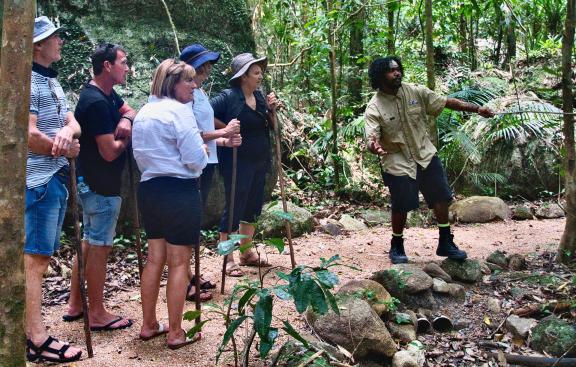
Source: MemoryCatcher at Pixabay, 2025
Think about your guides’ personalities, too. They must be personable, friendly and able to inspire a group with their natural communication skills. The person who knows the most is not always the best person to deliver the experience.
For help with training guides to deliver excellent experiences, see what you can learn from the article Tour Guide Training – the best tips and tools for your guides.
Consider the quality of interpretation
Provide detailed, interesting and relevant information about the cultural experience you are offering. This creates meaning and a deeper understanding for cultural tourists, and gives them a ‘sense of place’.
Good interpretation also generates customer satisfaction and benefits local tour operators. It will help you stand out from the crowd and generate good reviews, which can lead to additional bookings. It can also stimulate recommendations, raise awareness of local cultural issues and inspire interest.
Examples of good interpretation are:
- Making sure that historical facts are interwoven with interesting stories to contextualise the site/experience;
- Signage that makes good use of imagery and text;
- Well-designed trails and maps using attractive icons and including additional information to create extra interest.
Ensure your cultural product is authentic and unique
Cultural experiences must be carefully designed to show the destination’s heritage. Involving the local community makes the experience more unique. Ideally, visitors should be able to actively take part in the experience, such as by cooking, doing crafts and speaking the language. Successful cultural tourism products enrich both the visitor and the host.
The table below shows that community involvement is key to authentic, meaningful cultural tourism. Communities should not be involved in local tourism products where experiences risk being exploitative or disrespectful, or could spread incorrect information about a culture.
Table 1: Understand the difference between authentic and inauthentic cultural tourism products
| Examples of authentic cultural tourism experiences | Examples of cultural tourism experiences that are inauthentic and bad practice |
|---|---|
|
|
Source: Acorn Tourism 2025
If an overnight stay with a community is included in the cultural experience, providers must ensure that accommodations are reasonably comfortable. They do not have to be luxury, but private and secure toilet facilities should be provided. Cleanliness is extremely important for European travellers.
Incorporate sustainability into your business
Cultural tourism products should be developed using sustainable, responsible, and ethical principles for minimal negative environmental or community impact. You should also manage your business sustainably and encourage your guests to travel responsibly. Becoming a certified tour operator is an important step to consider. Sustainable tourism business practices are mandatory for European tour operators, so they need to work with suppliers who can prove they are sustainable.
Use these guidelines to make sure that sustainability is at the centre of your business:
- If you are a local tour operator, there are several well-known certification schemes in Europe. Some are very expensive. However, the best value and some of the most common are Travelife for Tour Operators, TourCert and the Good Travel Seal.
- For local operators that work in the tangible heritage sector, the UNESCO World Heritage Toolkit was developed to help managers of World Heritage Sites adopt best-practice approaches to sustainable economic development through tourism. There are 9 guides. Guides 1 to 4 establish the basic foundations for sustainable tourism. Guides 5 to 9 are aimed at specific issues. Consult each guide to see what can be adapted for your attraction.
- Some countries, like Costa Rica, have their own sustainability schemes. Other countries issue sustainability guidelines to support inbound tour operators and accommodation providers, such as India’s Sustainability Tourism for India. To find out whether there are similar schemes or guidelines in your country, look at the website of your Ministry of Tourism or National Tourist Board to see what publications are available.
- CBI has published several studies to help with the journey towards sustainability: 'How to be a sustainable tourism business', 'Tips to go green in the tourism sector' and 'Tips to become more socially responsible in the tourism sector'. Read them all to see what you already do, what can be improved and what further actions you can take.
- Look at what other local businesses do. This is important because customers are more likely to choose a tour that is promoted as sustainable than one that is not. Look at these case studies of successful sustainable tourism businesses that have effectively incorporated sustainability into their businesses.
2. Through which channels can you get cultural tourism products on the European market?
Cultural tourists are usually well-educated, care for the planet and its people and look for sustainability in travel. The end market, European tour operators, OTAs and direct sales are all good channels to reach European buyers. Independent travellers (FITs) are more likely to use OTAs to book cultural tourism products.
How is the end market segmented?
Cultural tourists span all age groups, and most of them appreciate cultural differences. They tend to be frequent travellers and value quality and comfort, but like to get to know local populations and how they live.
Cultural tourists can be broadly split into two major groups:
- Motivated cultural tourists travel specifically to experience and learn about a destination’s culture.
- Incidental cultural tourists are the largest group. They travel for other reasons, such as adventure, sun, beach or nature. They also enjoy participating in cultural activities if these fit in with their itineraries.
Tip:
- Find out more about the cultural tourism market in the study 'The European market potential for cultural tourism'.
Through what channels do cultural tourism products end up on the end market?
Cultural travel products are sold to European culture tourists directly by local providers, European tour operators, or an OTA (online travel agency). Sometimes, local providers sell their products to local DMCs (destination management companies), which then simultaneously supply European tour operators with a range of experiences. The figure below shows how the process works.
Figure 2: Sales channels for cultural tourism products
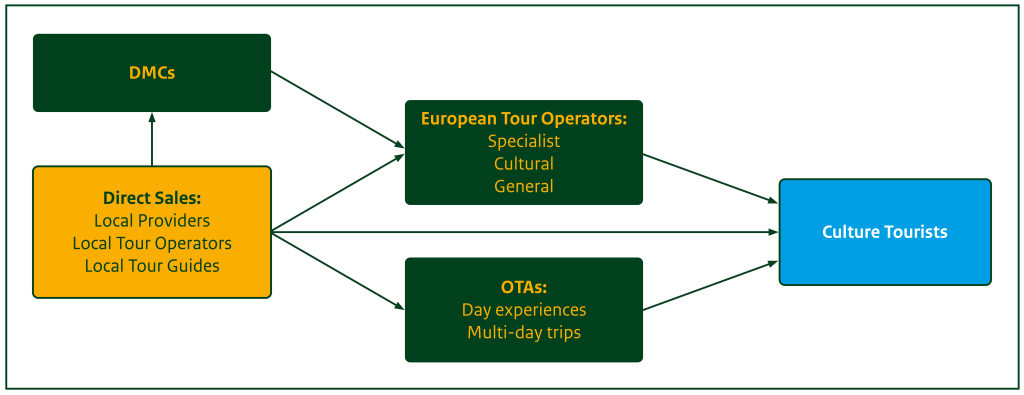
Source: Acorn Tourism Consulting, 2025
Examples of operators and businesses in each sales channel include:
- DMCs are local tourism businesses that provide inbound tour operators with various services, including experiences. They often belong to networks of DMCs, such as 1 DMC World and Global DMC Partners. Alternatively, you can find them online, such as Colombian DMC, Destination South Africa and Vietnam DMC.
- European tour operators (adventure, cultural, general) usually offer cultural experiences as an option within itineraries or provide holidays with a cultural focus. They include Exodus, Window to Travel, Classic Journeys and the Internet Traveller (UK); Nomade Aventure (France); Journaway (Germany); Sawadee Reizen (Netherlands); and Eden Viaggi (Italy).
- Specialist tour operators are more common in the UK market. They include Martin Randall Travel, ACE Cultural Tours and Cultural Breaks. Kudu Travel specialises in cultural walking tours. Intermedes is a specialist French operator.
- OTAs offering day trips – Viator is the biggest OTA platform for cultural tourism products. A lot of its trips and tours can be considered cultural experiences. They include bicycle and walking tours, sightseeing tours, cookery classes, shopping trips, history/heritage tours, guided museum trips and village visits. Others include Airbnb Experiences, GetYourGuide and Klook.
- OTAs offering multi-day trips include online marketplaces that European and local tour operators use to sell their tours. Responsible Travel, Travel Stride, TourRadar and Evaneos are popular examples.
Tip:
- Research OTAs on the market and download the guide '50 Specialist OTAs in Tours, Activities and Attractions'. Be aware that the OTA marketplace is fast-moving, and there are many new start-up businesses; some OTAs may no longer exist.
What is the most interesting channel for you?
Every sales channel is worth exploring, depending on your product and the market you want to attract.
Look carefully at attracting the FIT (fully independent travellers) market. This group likes to make its own travel plans and uses OTAs widely for travel services, including experiences. To target this market, you need a good website. The CBI study 'What are the opportunities in the European FIT tourism market?' will tell you more.
Tips:
- Read the CBI study 'How to be a successful business online' for useful information on creating or improving your website. A strong online presence is important in the tourism sector.
- Read the CBI guide 'How to work effectively with OTAs' to better understand this growing and dynamic market.
- Read CBI studies on finding and doing business with European buyers: '10 Tips for finding buyers on the European tourism market' and '10 Tips for doing business with European tourism buyers'.
3. What competition do you face in the cultural tourism market?
Every country has its own culture, heritage and traditions, and there are many opportunities for developing countries to promote unique and immersive cultural tourism offers to the European market. However, this is a very competitive market, and you need to work hard to stand out.
Which countries are you competing with?
We provide profiles of top cultural destinations Colombia, Ethiopia, India and Peru. You should also consider the following competing nations: Bhutan, Bolivia, Cambodia, Chile, Egypt, Ethiopia, Indonesia, Morocco, Nepal, Sri Lanka, Thailand, Uzbekistan and Vietnam.
Colombia
In recent years, Colombia’s reputation as a must-visit tourism destination has improved following the peace accord between the government and militant group FARC. Colombia has become popular as a tourism destination. In 2023, international arrivals increased by 23.5%, from 3.5 million to 4.3 million. The government has big plans for cultural tourism. This is part of the so-called ‘orange economy’, the sector that combines creativity, culture and commerce. Cultural tourism is one of the four pillars of Colombia’s tourism strategy.
Colombia’s vibrant mix of ancient civilisations, old colonial towns, indigenous communities and modern cities offers strong cultural tourism. The heritage visitor has many interesting sites, including the Ciudad Perdida, built between the eleventh and fourteenth centuries, and St Augustin, a mystical region with 500 life-sized ancient statues over 5,000 years old. Underground tombs, preserved old cities and numerous cobblestone towns and villages offer an excellent heritage destination.
The Spanish colonial era significantly influenced Colombian culture, which, combined with the native civilisations of Muisca and Tayrona, led to a vibrant, colourful culture of traditions, festivals, music and food. Many festivals are held annually, including the largest, Barranquilla Carnival, and the Flowers Festival in Medellín. Communities in many different rural regions of Colombia are establishing community-based tourism projects, such as guided trips to coffee farms, to help generate economic sustainability.
Cultural experiences in Colombia cross over with agritourism, another strong sector there. Colombia’s agritourism market is projected to grow from $1.1 billion (USD) in 2025 to $3.4 billion by 2035 – a CAGR (compound annual growth rate) of 11.8%. Visitors to Colombia are keen on community-based cultural experiences. In 2024, it was reported that 42% of visitors to the Quindíos coffee area stayed overnight at eco-fincas, or ecolodges, enjoying coffee experiences together with bird watching.
Ethiopia
Ethiopia has a rich cultural heritage. There are at least 80 different ethnic groups living in Ethiopia, many of whom have their unique language, art, dress, food and religion. Ethiopia has eight cultural UNESCO World Heritage Sites, including the rock-hewn churches of Lalibela, which also host the Timkat religious festival every year. The city of Axum is another key site, one of the religious centres of the Ethiopian Orthodox Church. Gondar is known for its walled fortress. Harar has several historical and cultural sites and is one of the earliest Muslim centres in this region of Africa.
The Omo Valley in southern Ethiopia is one of the country’s key cultural destinations. It is home to the unique Omo tribes, who have lived in the region for centuries and continue to live an unchanged traditional life. The region is popular for tourism, although some activities have been criticised for being ‘staged’ for photography purposes. This demonstrates how important it is that cultural tourism does not harm the communities visited.
The Ethiopian government has invested in developing the tourism sector in recent years, to make the country one of the top ten destinations in Africa. Using cultural and heritage tourism is a major strategy. It encourages visits to museums and historical sites. However, the country finds it difficult to meet targets because of security risks, bureaucracy and poor infrastructure. Despite this, arrivals have increased by 9% year on year – still short of the target, but an indicator of interest in Ethiopia as a country to visit.
Most cultural tourism in Ethiopia is undertaken alongside adventure tourism activities, as the country is a more challenging destination.
India
India has an exceptional cultural tourism offer that is both tangible and intangible. Its rich heritage over the centuries has had a significant impact on India’s culture, which is evident in music, dance, architecture, food and language. The sector is supported by the Ministry of Tourism and Culture, specifically created to boost cultural tourism. Its ‘Incredible India!’ campaign was developed to drive growth in cultural tourism. Its recently relaunched website is full of inspirational content.
Growth in the cultural tourism sector is driven by many factors, including the restoration of heritage sites, developments in the festival sector, new tourism circuits and food tourism developments. For instance, the Chettinad Heritage and Cultural Festival was developed by the local community to showcase their restored heritage homes as hotels and local culture. In 2025, Lucknow was chosen as a UNESCO Gastronomic Creative City. The city attracts 48 million visitors every year. Many come to experience the diversity of its food.
Figure 3: Food is an important part of India’s diverse culture
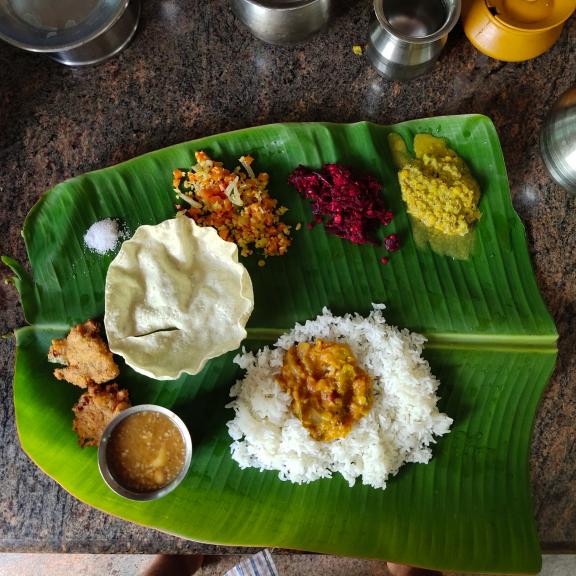
Source: Saktheeswaran Govindarajan at Unsplash, 2021
Rajasthan is the most popular state for cultural tourism. It is sometimes known as the ‘Culture Capital of India’ and showcases vibrant displays of colour and cultures through architecture, costumes, food, arts and festivals. The Rajput rulers were extravagant patrons of art and architecture, like the famous pink architecture of Jaipur and the iconic Lake Palace at Udaipur. The state also hosts many cultural festivals, including the Pushkar Camel Festival, the Jaisalmer Desert Festival and the Marwar Festival of Jodhpur.
Other important states for cultural tourism in India include Uttar Pradesh, home to the Taj Mahal, one of the world’s most famous buildings. Varanasi is a leading cultural and spiritual destination, located on the banks of the holy Ganges River. There are numerous temples and it is a famous pilgrimage destination.
In the south, Tamil Nadu is one of the world’s oldest civilisations, linked to Dravidian traditions and cultures. Hindu culture is especially vibrant, as seen in the many thousands of temples, including the 7th and 8th-century temples at Mamallapura, a UNESCO World Heritage Site.
Peru
Cultural tourism is one of the key reasons people visit Peru. Its most famous attraction is the UNESCO World Heritage Site Machu Picchu. Inca traditions are still practised in many small, rural, picturesque villages throughout the country. Indigenous people have preserved their ancient languages of Quechua and Aymara. Homestays with local communities and families are a common activity, particularly in the mountainous regions, and provide visitors with a real insight into Peruvian culture.
Machu Picchu and the Inca Trail are Peru’s major cultural attractions, attracting hundreds of thousands of visitors annually. Since 2000, visitors have not been able to visit without permits and guides, which has created opportunities for local people and operators to provide guiding services. The rules were changed again in 2024. There are now ten routes for visitors to choose from. This helps to avoid overwhelming single routes, and allows for different interests, fitness levels and time limits.
Figure 4: Machu Picchu – new rules 2024
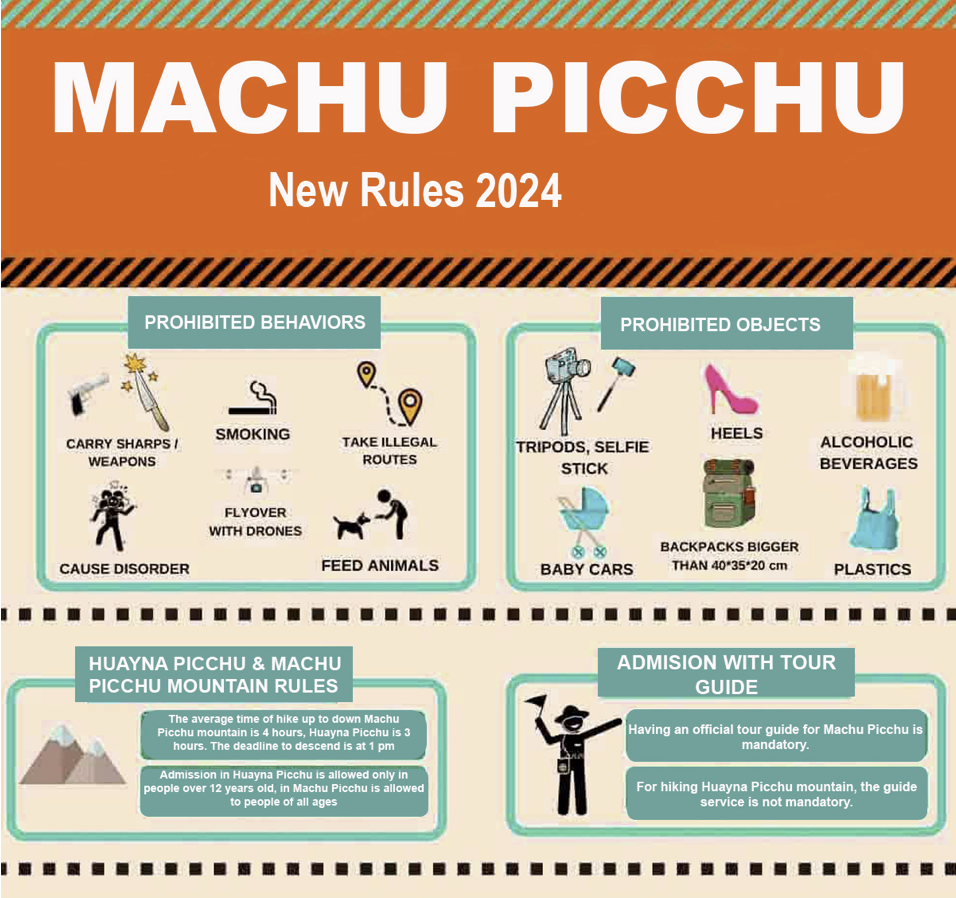
Source: Inca Trail Machu Picchu, 2025
Sustainable behaviour is heavily encouraged, such as staying on designated paths, following the route, leaving no trace, taking reusable water bottles and avoiding plastic ponchos in rainy weather by bringing proper rain jackets.
Machu Picchu has had problems because of overtourism. To make this less of an issue, Espíritu Pampa is being promoted as an alternative to Machu Picchu. It is a lesser-known Andean ruin, but an equally authentic destination. It is also known as the Lost City of the Incas.
Elsewhere in Peru, Arequipa, the ‘white city’ on account of the white volcanic rock on the front of its houses and churches, and Cuzco, the capital of the Inca empire, are other important cultural destinations. The small town of Puno, on the shores of Lake Titicaca, the highest navigable lake in the world, is a hotspot of Peruvian character and culture.
Key takeaways
- There is a strong link between cultural tourism and community-based tourism. Both rely on community interaction to be successful. These tourism types are very popular among European tourists who want authentic and meaningful experiences. Find out more about other niches in the CBI studies 'What are the opportunities on the European community-based tourism market?' and 'What are the opportunities on the European agritourism market?'
- Stay updated with any cultural developments promoted in your country. Make sure that you support and learn from these developments, as long as they are implemented sustainably.
- Encourage your visitors to behave responsibly and provide information on your website. You could consider creating a poster using an online graphic design tool like Canva. If you do not have these skills, find a design or technology student to help you.
Figure 5: How to be a responsible tourist
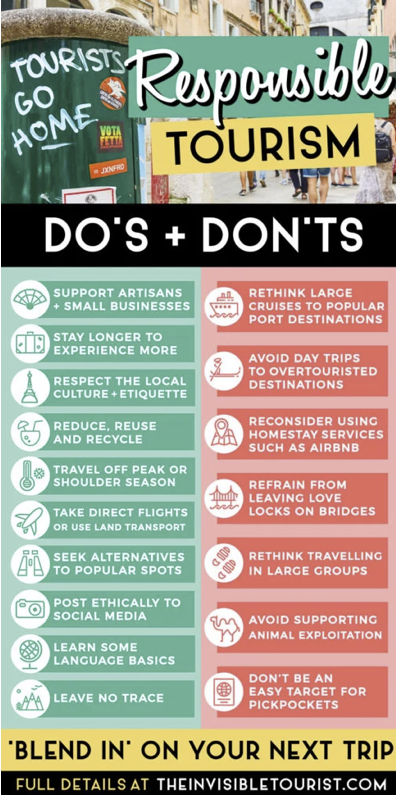
Source: The Invisible Tourist, 2025
Which companies are you competing with?
Local tour operators that offer cultural tourism experiences are common across all competing markets. They use a mix of direct sales and OTAs as their sales channels.
Colombia
Bogotá Graffiti Tour offers a range of free and paid walking tours of Bogotá’s graffiti sites. Its Original Bogotá Graffiti Tour is listed as the number one tour in Bogotá. It conducts two free daily tours at 10 am and 2 pm. It also offers private tours and workshops to learn the technique of art by aerosol. To book, this operator directs visitors to WhatsApp.
The website is simple, but bold and colourful. It features lots of pictures of graffiti and smiling tour guides, which is immediately inviting. It also has a useful guide on what to bring on the tour. This is presented as an infographic, providing a lot of information very simply. If you can include similar banners on your website, it will reassure your visitors.
Figure 6: Bogotá Graffiti Tour – what to bring
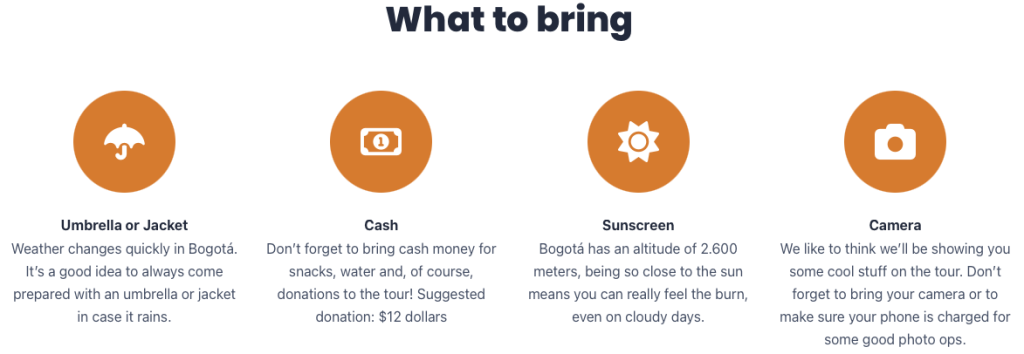
Source: Bogotá Graffiti Tour, 2025
Colombia Travel Operator promotes a range of day tours in Medellín, Bogotá and Cartagena, as well as multi-day trips that are generally tailor-made. Examples include, ‘Do Not Say That Name – Pablo Escobar Tour’, a day tour in Medellin, and a week-long tour through the coffee plantations and Andes mountains. A large banner at the top of the website highlights that it is locally owned and operated, and has had more than 15,000 satisfied customers since 2009. This is a good way to generate confidence among potential customers.
The operator has worked hard to help build its tourism offer since 2009. It supports AMI, an organisation that helps children and families living in Comuna 13, a low-income neighbourhood that was once one of the most dangerous places to live. They are members of several national associations, including Acotur, the Colombian Association of Responsible Tourism. It provides information about its sustainability policy and what it does to preserve the natural beauty of Colombia.
Ethiopia
Grand Holidays Ethiopia recently updated its website. Its use of scrolling images is inspirational. It offers a wide range of tours in Ethiopia, including cultural tours, such as a Best of the Omo Valley Photographic Tour, a Cultural Tour to the Historic Route of Ethiopia and the Simien Mountains Multi-Day Tour. Festival tours include the Meskel Festival, the Sebaratmu Festival and Ethiopian Easter Festival.
It has a strong, sustainable and responsible tourism philosophy, encouraging its clients to respect the social, cultural and religious beliefs of local communities. The website is available in English, German and Chinese. Its blog features a range of interesting articles, including the 15 best foods in Ethiopia and Ethiopian spring festivals.
Merit Ethiopian Experience Tours (MEET) is based in Addis Ababa and offers a range of day and multi-day tours that are sustainable, insightful and unique. Tours typically involve both culture and adventure elements, and city tours of Addis Ababa are a mix of history and culture. The website uses many inspirational images and provides information about Ethiopia and its attractions, including the unique culture of the Omo Valley tribes.
The operator also offers a series of special tours that are largely based around Ethiopian culture, such as the Rastafari Tour and a 10-day Historical and Cultural Tour of Northern Ethiopia. Visiting coffee plantations also features in many itineraries. The website has been optimised to translate into multiple languages. In 2024, this operator was awarded Most Client-Focused Bespoke Tour & Activities Agency by LUXlife Magazine.
Source Ethiopia Tours (SET) promotes a wide range of experiential tours throughout Ethiopia with interesting names, such as ‘Experience 56 Ethnic Groups in Seven Days’ and ‘Journey through the Origin of Spirituality following the Footprints of our Kings’. It offers multi-day and short trips. Guests can also enjoy a personal cooking class hosted by the operator’s owner, Daniel Ademe, and his family.
SET’s mission is clearly stated to benefit communities, visitors and sustainability. SET is a Travelife Partner.
India
The travel industry in India is very large. The Indian Association of Tour Operators (IATO) has more than 1,600 members serving several niche tourism segments, including history and culture. It is a useful resource for finding local operators by state who are competing businesses.
Royal Rajasthan Tour is a member of several national and regional tourism associations, including IATO. Cultural and historic tours visit all the leading destinations in the state, such as Jaisalmer, Udaipur and Pushkar. As well as tour packages, such the Majestic Rajasthan Fort Tour and the Unforgettable Palace Tours, it offers a wide range of services that are attractively presented in an infographic. If you offer a range of services, you could consider creating something similar on your website.
Figure 7: What we offer infographic

Source: Royal Rajasthan Tour, 2025
Vue India Tours offers tours by theme, which include ‘Culture and Heritage’ and ‘Fairs and Festivals’. Its homepage tagline ‘Explore. Dream. Discover’ is inspirational, and it uses images and videos on its homepage to good effect. This operator is both a DMC and a tour operator. Under the tagline ‘We Don’t Sell Tours, We Create Experiences’, it has published an impressive list of reasons to choose the operator, which include 23 years of experience, unmatched local experiences and quality transport, guides and drivers, which are all important factors to cultural tourists.
It provides very detailed information about each of the states it visits (accompanied by attractive images), and each itinerary is fully explained. Reviews are also widely featured throughout the site and are a mix of written reviews and videos.
Peru
European travellers to Peru are typically adventure tourists who also participate in both active and cultural experiences, including visiting Machu Picchu and other cultural sites, such as the Nazca Lines and Cuzco. Many operators provide guided hikes and trips to Machu Picchu or longer trips that usually follow a route.
Alternative Peru aims to help travellers ‘escape the masses and go beyond the beaten tourist path’ on unique, alternative and authentic experiences, with a focus on local culture. Its whole ethos is based around responsible travel, and it offers travellers ways to support projects or communities visited during their trip, such as donations and volunteering.
The Alternative Sacred Valley tour takes visitors off the beaten path to alternative archaeological sites in the Sacred Valley, meeting locals and leaving a positive footprint. A bilingual guide accompanies all trips. Its blog page features a range of interesting articles about Lima, sustainable travel, Peru, and more, including its post on responsible tourism, which provides insight into how it makes its tours sustainable.
Based in Cusco, SAS Travel has been offering sustainable, responsible and ethical cultural and trekking trips since 1990. It has received an accreditation award for its work from SERNAMP (National Service of Natural Areas Protected by the State), which establishes the policy for sustainable tourism. It offers many tours to Peru’s key cultural sites. The Heart of Cusco Tour is a non-profit tour of a local community project that helps and trains local families and promotes cultural, ecological and spiritual education.
The operator has been recommended by several leading travel guides, including Lonely Planet and Footprint Travel Guides, and makes good use of its Tripadvisor reviews and other testimonials.
Key takeaways
- It is essential that local tour operators providing cultural tourism products are sustainable. It is a good idea to mention sustainable actions on your website. European cultural travellers increasingly want tourism businesses to work actively to protect the local environment and communities.
- Be inventive in your website design. Use infographics to present simple messages, images and videos that inspire potential visitors. Make sure that you link your website to Tripadvisor and Google reviews. The CBI study 'How to be a successful tourism business online' can help you create or update your website.
- Create and maintain a blog page. This is a great way to get your website found through SEO (search engine optimisation). It will improve your reputation if you can talk about your country and destination, reasons to visit, local cultures, responsible tourism and so on. Make sure that you post blogs regularly, at least four times a year and spread evenly, so that you always appear up to date.
- Do your research on competing markets. See what they offer and how they present their cultural offer. You can learn a lot from others in the sector.
Which products are you competing with?
In developing countries, adventure tourism products are your biggest competitors. Adventure tourists usually enjoy adventure and cultural activities while travelling to a long-haul destination. Therefore, you must identify the main adventure activities in your region (e.g. hiking or trekking) and work to develop complementary cultural products to attract adventure tourists.
For more information about the adventure tourism market, read the CBI study 'What are the opportunities in the European adventure tourism market?'
4. What are the prices for cultural tourism products in the European market?
Prices for cultural trips and experiences vary by destination. Many built attractions have an entry fee, and depending on the attraction, they may have different pricing structures. International visitors sometimes pay more than nationals; group prices differ from individual tickets. Senior citizens and children usually pay less, and multi-day entry ‘savers’ may be offered. Make sure you know the entry prices for your local attractions.
For intangible cultural products, such as festival tickets or cooking classes, you should research the relevant prices and make sure you add them to your price structure.
You should understand all the other price components in your tourism product, including transportation, guides, food and beverages (if included), accommodation (if included) and any contributions you make to conservation or charitable organisations.
The table below gives a broad indication of prices on the European market, excluding international airfares.
Table 9: Examples of prices for cultural tourism trips and holidays in 2025
| Tour | Country | Duration | Price per person (€) |
|---|---|---|---|
| Cultural and religious half-day tour in Jaipur with a local | India | 8 hours | 9 |
| The hidden secret of the vibrant tradition in Varanasi | India | 3 hours | 12 |
| Cookery class and dinner with a local family, Udaipur | India | 3 hours | 12 |
| Authentic Ethiopian cookery class and coffee ceremony | Ethiopia | 4 hours | 35 |
| Kerala backwater village kayaking tour | India | 5 hours | 46 |
| Authentic Addis Ababa city tour with a local guide | Ethiopia | 8 hours | 48 |
| Wilderness and culture in Kerala | India | 8 hours | 79 |
| Walking tour in Cartagena | Colombia | 3 hours | 90 |
| The Shipibo community in Lima | Peru | 5–6 hours | 106 |
| Cusco women – reality and hope | Peru | 4 hours | 119 |
| Art and culture in historic Callao | Peru | 4–5 hours | 120 |
| Do not say that name – Pablo Escobar tour, Medellín | Colombia | 4 hours | 124 |
| Full-day authentic Lima tour | Peru | 8 hours | 128 |
| Culture tour of Darjeeling | India | 4 days | 185 |
| Andean community stay | Peru | 3 days | 257 |
| Coffee farm and tasting tour, Bogotá | Colombia | 8 hours | 266 |
| Overnight tour to Lalibela | Ethiopia | 2 days | 419 |
| Omo Valley tribal tours | Ethiopia | 2 days | 432 |
| Cultural seven-day trip in Colombia | Colombia | 7 days | 856 |
| Southern Ethiopia tour | Ethiopia | 6 days | 1,166 |
Source: Acorn Tourism Consulting, 2025
Tips:
- Read the CBI study '10 tips for doing business with European buyers' and scroll to tip 8: 'Set a fair price for your product'.
- For more advice about setting prices, download Tourism Northern Ireland's guide 'Pricing for Profitability'.
- Research typical prices for cultural tourism products in your destination. This way, you can be sure that your prices are competitive.
Disclaimer: The statistics quoted in this study are drawn from various sources. Due to variations in data collection and presentation methods, figures may not always be directly comparable.
This study was carried out by Acorn Tourism Consulting Limited on behalf of CBI.
Please review our market information disclaimer.
Search
Enter search terms to find market research

